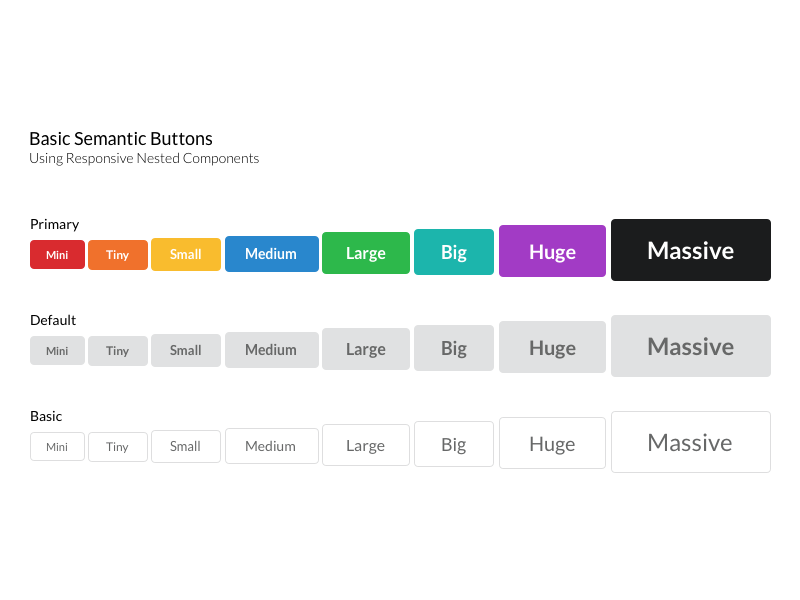

- #Semantic ui responsive layout how to
- #Semantic ui responsive layout zip file
- #Semantic ui responsive layout update
The training gave some sound advice: "Think about how to solve the problem with React’s declarative composability because nearly every 'React Router question' is probably a 'React question'". This React Training gives an excellent example of how to dynamically redirect a user to a different component based on a responsive media query.Īlthough the Responsive Routing I described above is a clean way to compose routes given different screen sizes, I realized the problem I needed to solve was a bit simpler. Similar to CSS media queries, React has a Media Component that listens for CSS media query responses and renders components if the query matches. React also has a way to make routes responsive to different screen sizes. React wanted to change this style, so since v4 routing takes place dynamically as the app is rendering. The philosophy is that frameworks like Rails use static routing, where routes are declared before any rendering takes place. I initially came across a feature in React called Dynamic Routing. The question then was - how do I do that?

So I decided I would create a new simple landing page for mobile that would replace the map, which would just appear on desktop and tablet screens. It would either be so zoomed in that the user could only see a few countries at a time, or way too zoomed out and small to click on a particular country.Īlthough I liked visually presenting project data through the world map component, I realized that I needed to explore new options to make my website user friendly on mobile. While I was able to make the world map responsive on larger screen sizes using some D3 methods and an event listener for window resize, the map just would not look good on mobile screens. The main page of my nonprofit donation website, EffectiveDonate, is a world map that uses data visualization with the React D3 Library. Also, my Navbar component (referred to as "Menu" in Semantic UI) needed some work to look good on mobile, so I'll cover the changes I made to that component as well! I had a specific component in one of my projects that needed to be bypassed in order for my website to be optimal on mobile, and I will go through the steps I took to tackle that issue. This article can’t really go into how to do that for your site, but this is how I wrapped my render/3 function in web/templates/layout/ this post I'll cover some strategies to make your React application more responsive.

#Semantic ui responsive layout update
Once we’ve removed bootstrap our pages will look pretty basic, it is now time to update those classes! You can do this by removing /assets/css/phoenix.css Updating some classes We still have bootstrap CSS being loaded in though, we should remove it. Removing Bootstrapīy this point we should be ready to go, we’ve all the files we need being loaded in. This is to reflect the new location of the font files. We need to change those paths to end up looking like this url (./ fonts / icons. Open up and search for “fonts/icons.eot”, you will see a line beginning with and it will have lots of paths to some fonts. Right now there are some fonts being loaded in at a path that no longer exists. Once we have these files in place there is one small change we need to make to the file. Find the flags.png image and move it into assets/static/images/.Move the fonts folder (and all contents) into assets/static.Find the file and move it into assets/css/.Find the file and move it into assets/js/.
#Semantic ui responsive layout zip file
Once we have that zip file downloaded we can extract it and move some of the files to their new homes. Our site are using are fixed and aren’t going to break on us. What we lose in being able to update quickly we gain from the knowledge that the files So I opted to just grab the files from their site and manually add them. There are someīuild tools that work out of the box with Semantic UI, brunch isn’t one of them The first thing we need to do is get the files from Semantic UI. I want to use Semantic UI to style the pages I’m making on a Phoenix project. I’m guessing if you’ve searched and found this post that you know what Semantic UIĪnd Phoenix are, if not here are some lightening fast definitions.Ī development framework that helps create beautiful, responsive layouts using human-friendly HTML.Ī productive web framework that does not compromise speed and maintainability. Out of the box Phoenix supports Bootstrap, which is great and all but I’ve heardĪ lot of good things about Semantic UI and wanted to give it a go. In this post I will guide you through what I did in order to get Semantic


 0 kommentar(er)
0 kommentar(er)
